The digital landscape has transformed dramatically in recent years, with Over-the-Top (OTT) and Video-on-Demand (VOD) services revolutionizing how audiences consume content. As consumers shift from traditional television to online streaming platforms, marketers are also adapting, using these channels to reach more targeted and engaged audiences. But what exactly is OTT and VOD marketing, and how can businesses leverage these tools to enhance their brand presence?
What is OTT?
Over-the-Top (OTT) refers to any media service that is delivered directly to viewers over the internet, bypassing traditional cable or satellite television platforms. Instead of relying on cable TV subscriptions, consumers access content via internet-enabled devices such as smart TVs, smartphones, tablets, and gaming consoles. OTT platforms include services like Netflix, Hulu, Amazon Prime Video, Disney+, and even YouTube.
What is VOD?
Video-on-Demand (VOD) refers to video content that viewers can access at any time they choose, rather than following a traditional broadcast schedule. VOD services provide a library of content that users can watch whenever they want, typically via streaming or downloading. Examples of VOD include Netflix, HBO Max, and Apple TV, as well as more niche services like fitness apps or educational platforms that offer video content on demand.
OTT vs. VOD: What’s the Difference?
While OTT and VOD are often used interchangeably, there is a distinction. OTT refers specifically to the method of delivery—streaming video over the internet without traditional television providers. VOD, on the other hand, refers to the format in which the content is provided (on-demand, as opposed to live or linear TV). VOD content can be delivered through OTT platforms, making the two terms related but not identical.
The Rise of OTT and VOD Marketing
As the popularity of OTT and VOD continues to rise, so does their importance in the world of marketing. These platforms offer a unique opportunity for brands to reach highly engaged and specific audiences, making them an invaluable part of any modern marketing strategy.
Here’s why OTT and VOD marketing are becoming essential:
- Targeted Advertising:
OTT and VOD platforms provide advertisers with the ability to target their ads much more precisely than traditional television. Instead of casting a wide net through generic TV spots, brands can now tailor their messaging to specific demographics, geographic locations, and even viewer interests based on data collected from streaming behavior. This level of precision increases the chances that ads will resonate with the right audience, leading to higher engagement and conversion rates.
- Engaged Audiences:
The nature of OTT and VOD services creates highly engaged viewers. Audiences who actively choose what to watch tend to be more invested in the content compared to traditional TV viewers who might passively watch scheduled programming. This engagement extends to ads as well. Unlike traditional TV ads that can be easily skipped or ignored, many OTT platforms integrate ads into the content, ensuring that viewers are exposed to them without disruption.
- Cross-Device Reach:
OTT and VOD content is consumed on a variety of devices, from smart TVs and laptops to mobile phones and tablets. This multi-platform usage gives marketers the ability to reach their audience wherever they are, offering flexibility in campaign planning and ensuring that their message is seen across multiple touchpoints.
- Real-Time Analytics:
One of the biggest advantages of OTT and VOD marketing is access to real-time data. Marketers can track how well their ads perform in terms of views, clicks, and conversions, allowing them to adjust their campaigns on the fly to maximize results. This is a significant improvement over traditional TV advertising, where performance metrics are often vague and delayed.
- Cost-Effective Advertising:
Unlike traditional TV advertising, which can be expensive and inefficient, OTT and VOD advertising is often more affordable and provides a higher return on investment (ROI). Advertisers can choose to pay based on actual views or engagement rather than impressions, ensuring that they are only spending money on ads that are truly reaching their target audience.
How to Leverage OTT and VOD Marketing
For businesses looking to incorporate OTT and VOD marketing into their overall strategy, here are a few tips:
- Choose the Right Platforms: Not all OTT platforms are created equal. Depending on your audience, some services may be more effective than others. For example, Hulu might be better for a younger demographic, while Amazon Prime Video could target a more diverse audience.
- Create High-Quality Content: Just like with any advertising campaign, the quality of your content matters. Make sure that your ads are engaging, visually appealing, and aligned with your brand’s message to capture viewers’ attention.
- Leverage Data for Personalization: OTT and VOD platforms allow for highly personalized advertising. Use data-driven insights to tailor your messaging and reach the right audience at the right time.
OTT and VOD marketing represent a new frontier in advertising, offering businesses unprecedented access to targeted, engaged audiences. As more consumers turn to streaming platforms for their entertainment, it’s crucial for brands to embrace these technologies and develop creative, data-driven marketing campaigns that stand out in the crowded digital space.






